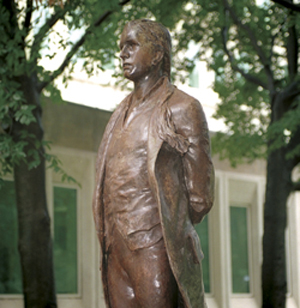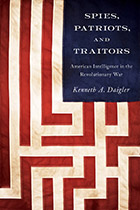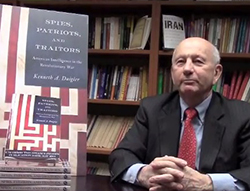Spies, Patriots and Traitors

(The statue of Nathan Hale stands guard between the CIA Auditorium and the Original Headquarters Building (OHB). It serves as a constant reminder to CIA employees of the duties and sacrifices of an intelligence officer.The 21 year-old-Captain in the Continental Army volunteered to collect intelligence on His Majesty’s forces on Long Island. He was caught on his first mission, and executed. His last words, “I regret that I have but one life to lose for my country,” circle the base of the statue).
I did not stay awake long enough to watch much of the game, and as it turned out, it was a wise decision. Having retired with the arrival of the big storm-front, I was up equally early and casting about for something that did not involve beheadings or hashtag diplomacy against barbaric savages.
I found it in a marvelous new book by Kenneth Daigler, a professor at Georgetown University. If you are interested in tradecraft and the art of Human Intelligence, this is an invaluable addition to your library, and it take you far beyond the worlds of Nathan Hale and Benedict Arnold, the two spies we remember out of a much larger intelligence world in the rebellious colonies.
Bill Manthorpe, a retired colleague and former Deputy Director of Naval Intelligence, alerted me to the book, with his review below.
I bought it on Kindle, since I am trying to lean down my holdings of paper volumes in what will probably be a mobile library in the near term. And as for me today , I am going to face the music and motor down to the farm to cut the pastures. And yes, I will stop to get safety goggles on the way. It is the intelligent thing to do.

Kenneth A. Daigler, Spies, Patriots and Traitors: American Intelligence in the Revolutionary War (Washington, DC: Georgetown University Press, 2014).
This is a unique book both an interesting history and useful textbook. As a history, it is impressive in both scholarship and readability. I had previously done considerable reading on the Founding Fathers, the Revolution, its military campaigns, and intelligence. Yet, I learned much that I had not known about what went on behind the scenes before and during the Revolution. But, more importantly, it is a valuable textbook. I spent at least half of my 40-year career conducting HUMINT, CI and deception operations, while learning on the job from British tales of WWII and hard experience. This is the textbook and desk-side reference that I wish that I had read years ago. Every trainee at the Farm should be required to read and discuss these case studies.
– William Manthorpe, Former Deputy Director of Naval Intelligence
From Georgetown University Press:

(Kenneth A. Daigler)
Students and enthusiasts of American history are familiar with the Revolutionary War spies Nathan Hale and Benedict Arnold, but few studies have closely examined the wider intelligence efforts that enabled the colonies to gain their independence. Spies, Patriots, and Traitors provides readers with a fascinating, well-documented, and highly readable account of American intelligence activities during the era of the Revolutionary War, from 1765 to 1783, while describing the intelligence sources and methods used and how our Founding Fathers learned and practiced their intelligence role.
The author, a retired CIA officer, provides insights into these events from an intelligence professional’s perspective, highlighting the tradecraft of intelligence collection, counterintelligence, and covert actions and relating how many of the principles of the era’s intelligence practice are still relevant today. Daigler reveals the intelligence activities of famous personalities such as Samuel Adams, George Washington, Benjamin Franklin, Nathan Hale, John Jay, and Benedict Arnold, as well as many less well-known figures. He examines the important role of intelligence in key theaters of military operations, such as Massachusetts, New York, New Jersey, Pennsylvania, and in General Nathanael Greene’s campaign in South Carolina; the role of African Americans in the era’s intelligence activities; undertakings of networks such as the Culper Ring; and intelligence efforts and paramilitary actions conducted abroad.
“Spies, Patriots, and Traitors” adds a new dimension to our understanding of the American Revolution. The book’s scrutiny of the tradecraft and management of Revolutionary War intelligence activities will be of interest to students, scholars, intelligence professionals, and anyone who wants to learn more about this fascinating era of American history.”
Copyright 2014 Vic Socotra
www.vicsocotra.com
Twitter: @jayare303
